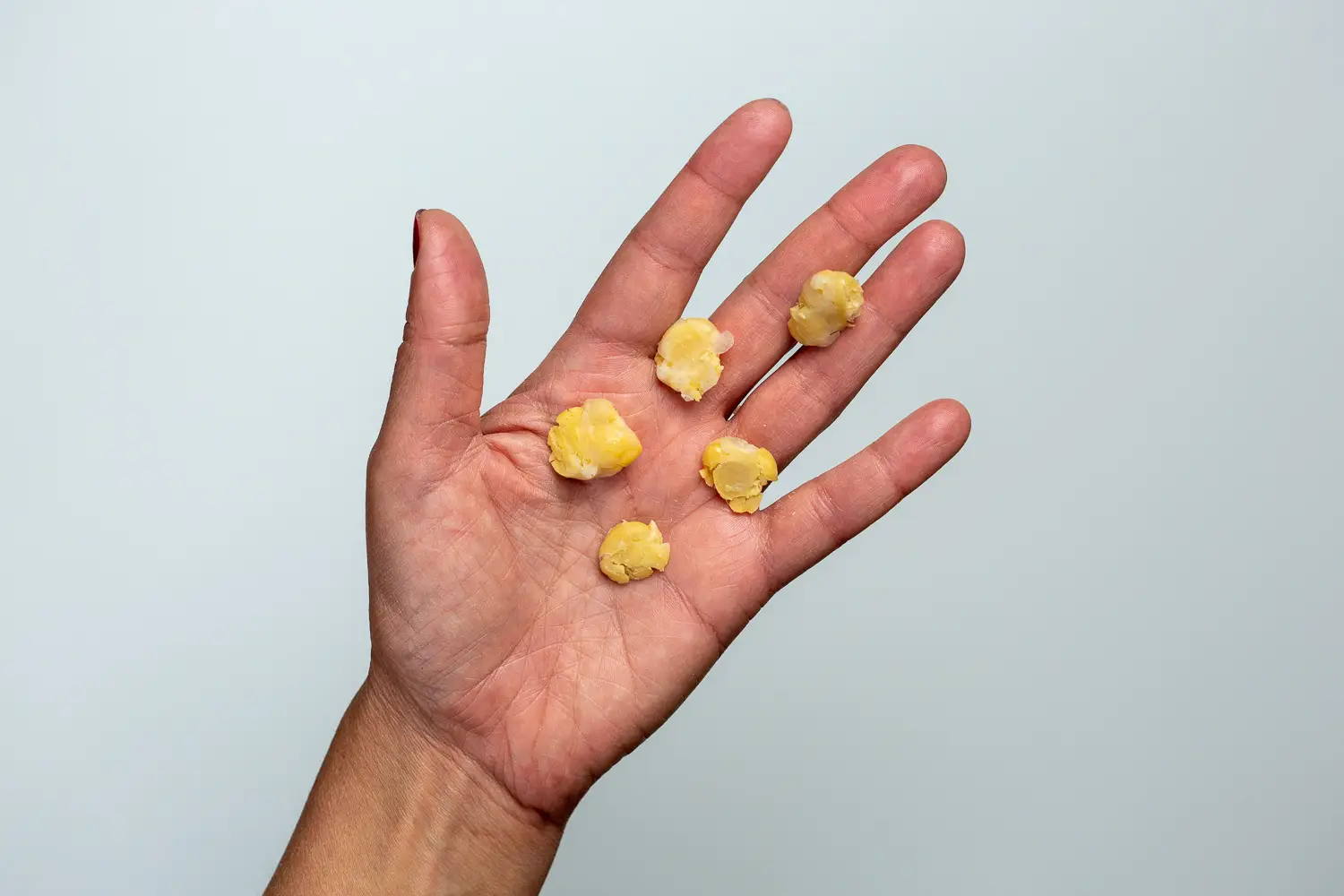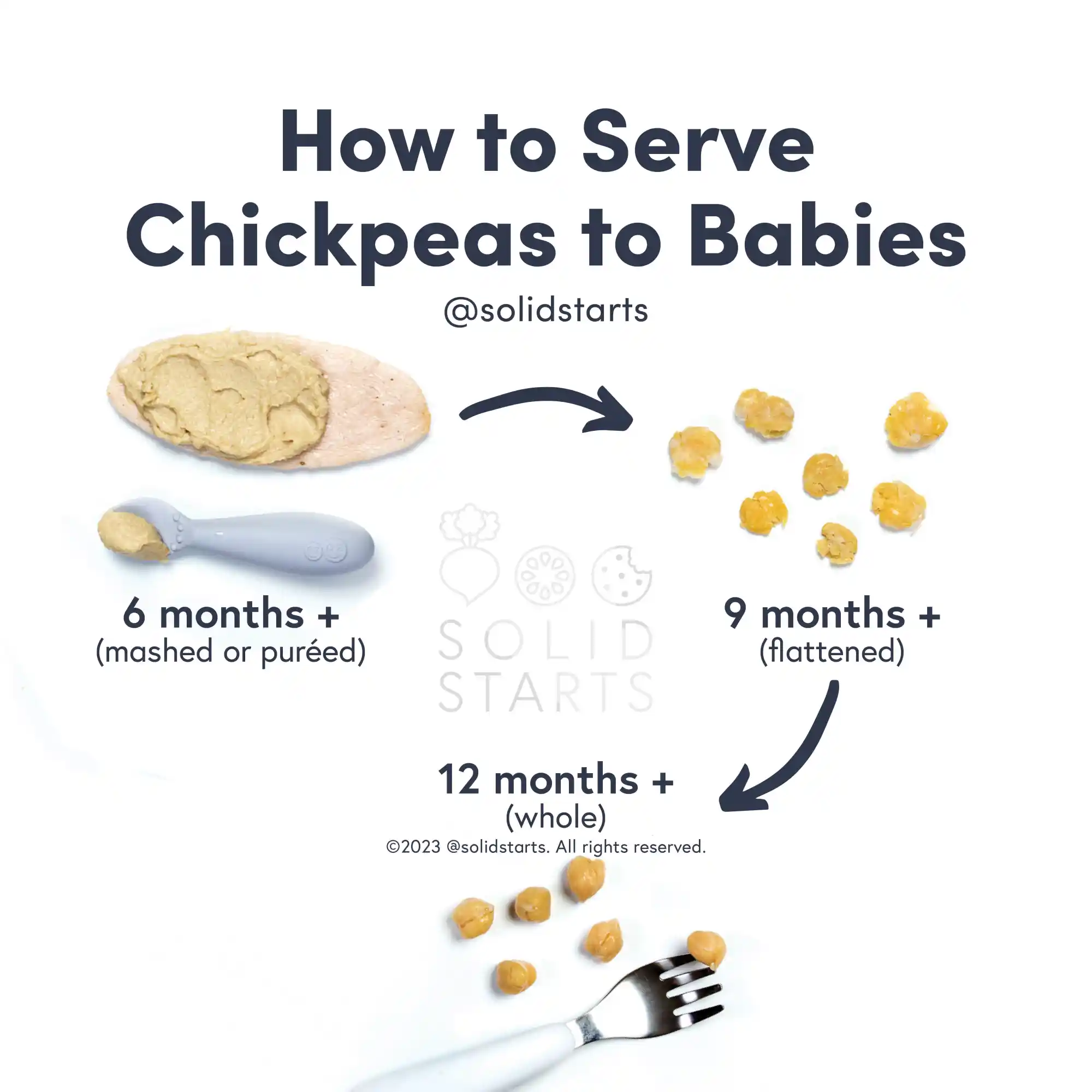Access our First Foods® Database in the Solid Starts App.
Learn moreChickpea
Legume
Age Suggestion
6 months
Iron-Rich
Yes
Common Allergen
No

Warning
Whole chickpeas present a potential choking hazard for babies, so read on for how to serve them safely for baby’s specific age.
When can babies have chickpeas?
Chickpeas may be introduced as soon as baby is ready to start solids, which is generally around 6 months of age.
Chickpeas originated in the lands around the Mediterranean Sea in ancient times, and today they are a staple food for cultures around the world. The popular legume goes by countless names: bengal grams, ceci beans, chana, desi chana, garbanzo beans, kadale kaalu, nokhod, sanaga pappu, and shimbra, to name a few. Color, shape, and size also varies, but the Kabuli and Desi varieties are the most widely available worldwide.
How do you serve chickpeas to babies?
Every baby develops on their own timeline, and the suggestions on how to cut or prepare particular foods are generalizations for a broad audience.
6 months old +:
Smash or blend cooked chickpeas into a textured mash or paste and serve in a bowl for baby to scoop. The thin skin on each chickpea is not a choking hazard, but it can cause some gagging if it sticks in baby’s mouth, so feel free to remove them or leave them on. You can also offer hummus, just make sure that sesame has been ruled out as an allergen if the hummus contains sesame. Alternatively, use chickpea flour to make dosa, idli, or pancakes to share with baby.
9 months old +:
Babies with a developing pincer grasp (where the thumb meets the pointer finger) may graduate to chickpeas that are fully cooked until soft and flattened with your thumb or fork to minimize the risk of choking. Alternatively, tear dosa, idli, or pancakes made with chickpea flour into bite-sized pieces and let baby practice picking them up. You can also continue to offer hummus or mashed chickpeas.
12 months old +:
Continue to serve flattened chickpeas, and try flattening them a little less as the child’s eating skills mature and your comfort increases. At this age, many toddlers are also ready to eat whole chickpeas that are fully cooked until soft. Before you offer one, assess the child’s eating ability. If you see the child consistently chewing well and not stuffing their mouth, and you feel comfortable, try offering a whole chickpea in a safe eating environment. Make sure to offer one at a time at first, model how to crush the chickpea with your teeth, and stay within arm’s each of the child.

Get baby’s caregivers on the same page as you with our guide, Baby-led Weaning with Daycare & Caregivers.
Videos
Are chickpeas a choking hazard for babies?
Yes. Whole chickpeas are small, round, and can be firm when raw or undercooked, qualities that increase the risk of choking. To reduce the risk, prepare and serve chickpeas in an age-appropriate way as described in the How to Serve section. As always, make sure you create a safe eating environment and stay within an arm’s reach of baby during meals.
Learn the signs of choking and gagging and more about choking first aid in our free guides, Infant Rescue and Toddler Rescue.
Are chickpeas a common allergen?
While not considered a common allergen in the United States, chickpeas are a common allergen in India and Spain. Reactions can occasionally be severe and in some cases have been reported to be triggered by exercise. Some individuals who are allergic to chickpea experience asthma symptoms after inhaling the vapors from steamed chickpeas.
Note that hummus, which is made from blended chickpeas, usually contains sesame (a common allergen) in the form of tahini, a sesame seed paste. Many individuals who experience symptoms of allergy after hummus consumption falsely attribute them to its chickpea content, when sesame is the more common food allergen.
Being allergic to one type of legume does not necessarily mean that an individual will be allergic to all others, although the risk of more than one legume allergy can increase. Chickpea allergies have been reported in some patients with allergies to other legumes. In particular, allergies to chickpeas and lentils may coexist.
Individuals with allergies to birch or plane tree pollen and/or Oral Allergy Syndrome (also called pollen-food allergy syndrome) may be sensitive to legumes such as chickpeas. Oral Allergy Syndrome typically results in short-lived itching, tingling, or burning in the mouth and is unlikely to result in a dangerous reaction.
As with all new foods, start by introducing a small amount of chickpeas for the first few servings and watch closely. If there is no adverse reaction, gradually increase the serving size over future meals.
Are chickpeas healthy for babies?
Yes. Chickpeas are an incredibly nutritious legume, rich in protein, carbohydrates, and fiber, high in the key nutrients that babies need to thrive, including folate, iron, vitamin B6, choline, and zinc. Collectively, these nutrients support baby’s neurodevelopment, metabolism, growth, as well as taste and smell perception.
★Tip: Vitamin C helps increase the body’s absorption of iron from plant sources, so serve chickpeas with other foods that are high in vitamin C, such as asparagus, bell pepper, cauliflower, or peas.
Can babies have canned chickpeas?
Yes, babies can have canned chickpeas or fully cooked dried chickpeas.
Are the lectins in chickpeas safe for babies?
Yes. Often called anti-nutrients, these naturally-occurring plant compounds (including lectins, oxalates, and phytates) break down during the soaking and cooking process and are generally harmless in most individuals when consumed as part of a balanced diet. Lectins and oxalates can even offer health benefits, such as antioxidant and anti-cancer properties.
Do chickpeas need to be soaked before cooking?
No, although soaking dried chickpeas can reduce cooking time and ensure that they are cooked all the way through, while also reducing the levels of lectins and a gas-producing carbohydrate, raffinose.
Here are a couple of common soaking methods:
Overnight soak: Use a ratio of 1 lb (454 g) of dried beans and 10 c (2 ½ liter) water, and soak the beans in water for 4 or more hours or overnight. Drain and rinse the beans prior to cooking.
Hot soak method: Use a ratio of 1 lb (454 g) of dried beans and 10 c (2 ½ liter) water, and bring the mixture to a boil for 2-3 minutes. Turn off the heat, then soak for a few hours. Drain and rinse the beans prior to cooking.
★Tip: Cooking dried chickpeas and finding they won’t soften? It’s possible they are past their prime. While chickpeas are shelf stable for a couple of years, chickpeas that are more recently packed will cook more fully and easily than older ones.
Our Team
Written by
Expert Tips Delivered to Your Inbox
Sign up for weekly tips, recipes and more!
Copyright © 2025 • Solid Starts Inc







